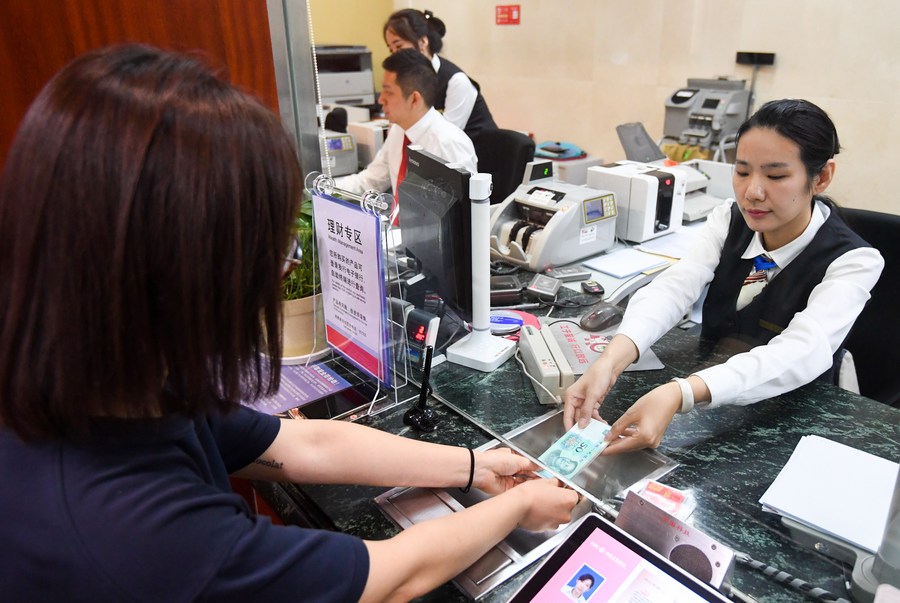Financial literacy of Chinese consumers improving, central bank report shows
A report from the People’s Bank of China (PBOC), China’s central bank, has found that the level of financial literacy amongst Chinese consumers has improved notably. In international terms, the report ranked Chinese consumers at an upper-middle level when it came to financial literacy.

A staff member (right) hands over a stack of renminbi banknotes to a customer at an Industrial and Commercial Bank of China (ICBC) branch in Beijing, Aug 30, 2019. (Photo/Xinhua)
The “Consumer Financial Literacy Survey and Analysis Report (2021)” gave Chinese consumers an overall score of 66.81 for financial literacy in 2021, an increase of 2.04 compared to 2019. It said Chinese consumers performed comparatively well in terms of their financial attitudes and improved notably in terms of their financial techniques.
The report said that Chinese consumers now know more about basic financial knowledge in the areas of credit, insurance, loans, deposits, and the calculation of annualized returns, finding that 85.15 percent of respondents affirmed their awareness of the consequences a bad credit history would have on their application for loans, while 71.03 percent of respondents indicated knowledge of the rules regarding unconditional insurance cancellation.
The financial behaviors of Chinese consumers have improved notably, according to the report. Compared with 2019, Chinese consumers’ credit card repayment behavior has improved significantly. The proportion of full repayments of credit card debt increased by 8.2 percentage points, and the proportion of minimum repayments of credit card debt, along with the number of consumers having an insufficient ability to make a repayment, dropped by 2.81 percentage points. Meanwhile, the number of people who carefully read contract terms increased by 12.31 percentage points.
The financial attitudes of Chinese consumers have also improved. The report pointed out that Chinese consumers are generally cautious about consumption when they owe money to the bank and only 23.57 percent said they would consider borrowing up to an agreed upon maximum threshold when purchasing large commodities. Nearly 90 percent of the respondents recognized the importance of financial education, with most believing that a financial education curriculum at school is the most effective way to provide financial education for youth.
The financial techniques of Chinese consumers have similarly become stronger. On the whole, Chinese consumers perform well in the daily management of income and expenditures, and most of them are in a state of budget surplus or an income-expenditure balance. The report found that 78.41 percent of respondents could afford unexpected expenses equivalent to three months of their incomes. Among those having cultivated the habit of reading contracts, more than 80 percent of the respondents said they could understand the key terms in financial product contracts. In terms of handling financial-related consumer disputes, the respondents were basically able to choose the correct complaint channel.
These improvements in consumer financial literacy can be attributed to the rapid development of the country’s financial industry in addition to strengthened publicity and the popularization of financial knowledge, as well as efforts taken by consumers themselves to become financially literate. Compared with 2019, the proportion of consumers who think financial education is very important has increased by 14.04 percentage points, while the proportion of consumers who think financial education is unimportant has dropped by nearly 10 percentage points.
Photos
 Bumper harvest presents a magnificent scene of terraced rice paddies in SW China's Luzhou city
Bumper harvest presents a magnificent scene of terraced rice paddies in SW China's Luzhou city In pics: life of Siberian tigers in NE China's breeding center
In pics: life of Siberian tigers in NE China's breeding center Explore wonderland created by an alpine lake cluster in SW China's Yunnan
Explore wonderland created by an alpine lake cluster in SW China's Yunnan In pics: Museums across China unveil creative and culturally-inspired mooncakes
In pics: Museums across China unveil creative and culturally-inspired mooncakes
Copyright © 2021 People's Daily Online. All Rights Reserved.






